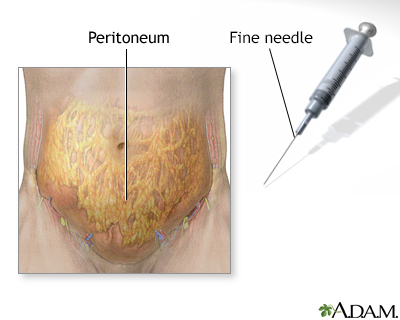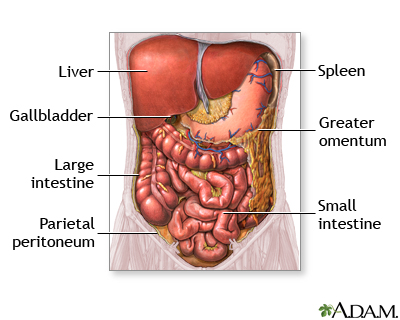Pregnancy SmartSiteTM
Acute abdomen; Spontaneous bacterial peritonitis; SBP; Cirrhosis - spontaneous peritonitis DefinitionPeritonitis is an inflammation (irritation) of the peritoneum. This is the thin tissue that lines the inner wall of the abdomen and covers most of the abdominal organs. CausesPeritonitis is caused by a collection of blood, body fluids, or pus in the belly (abdomen). One type is called spontaneous bacterial peritonitis (SBP). It occurs in people with ascites. Ascites is the buildup of fluid in the space between the lining of the abdomen and the organs. This problem is found in people with long-term liver damage, certain cancers, and heart failure. Peritonitis may be a result of other problems. This is known as secondary peritonitis. Problems that may lead to this type of peritonitis include:
SymptomsYour belly is very painful or tender. The pain may become worse when your belly is touched or when you move. Your belly may look or feel bloated. This is called abdominal distention. Other symptoms may include:
Exams and TestsYour health care provider will perform a physical exam. The abdomen is usually tender. It may feel firm or board-like. People with peritonitis usually curl up or refuse to let anyone touch the area. Blood tests, x-rays, and CT scans may be done. If there is a lot of fluid in the belly area, your provider may use a needle to remove some and send it for testing. TreatmentThe cause must be identified and treated right away. Treatment typically involves surgery, antibiotics, or both. Possible ComplicationsPeritonitis can be life threatening and may cause complications. These depend on the type of peritonitis. When to Contact a Medical ProfessionalGo to the emergency room or call 911 or the local emergency number if you have symptoms of peritonitis. ReferencesBush LM, Levison ME. Peritonitis and intraperitoneal abscesses. In: Bennett JE, Dolin R, Blaser MJ, eds. Mandell, Douglas, and Bennett's Principles and Practice of Infectious Diseases. 9th ed. Philadelphia, PA: Elsevier; 2020:chap 74. Kuemmerle JF. Inflammatory and anatomic diseases of the intestine, peritoneum, mesentery, and omentum. In: Goldman L, Cooney KA, eds. Goldman-Cecil Medicine. 27th ed. Philadelphia, PA: Elsevier; 2024:chap 128. | |
| |
Review Date: 3/31/2024 Reviewed By: Debra G. Wechter, MD, FACS, General Surgery Practice Specializing in Breast Cancer, Virginia Mason Medical Center, Seattle, WA. Also reviewed by David C. Dugdale, MD, Medical Director, Brenda Conaway, Editorial Director, and the A.D.A.M. Editorial team. The information provided herein should not be used during any medical emergency or for the diagnosis or treatment of any medical condition. A licensed medical professional should be consulted for diagnosis and treatment of any and all medical conditions. Links to other sites are provided for information only -- they do not constitute endorsements of those other sites. No warranty of any kind, either expressed or implied, is made as to the accuracy, reliability, timeliness, or correctness of any translations made by a third-party service of the information provided herein into any other language. © 1997- A.D.A.M., a business unit of Ebix, Inc. Any duplication or distribution of the information contained herein is strictly prohibited. | |

 Peritoneal sample
Peritoneal sample Abdominal organs
Abdominal organs
